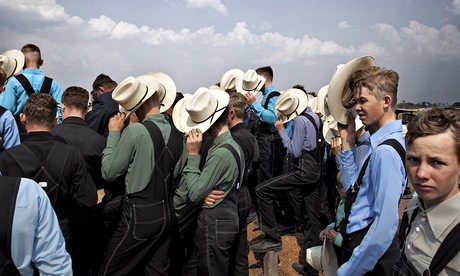
In 2010 and 2011, Jordi Ruiz Cirera photographed the Mennonites of Santa Cruz, east Bolivia. He was fascinated by their austere lifestyle in a dusty, windswept landscape where farming was a daily struggle. “The huge extensions of land, the isolation and the remote communities, was strongly related to their relation with God,” he writes in the foreword to his forthcoming book, Los Menonos. “Like the cattle and the pastor – all together, all united.”
Slowly, Ruiz Cirera won the trust of people in the community, many of whom were so suspicious of photography that they’d never had their picture taken. He befriended Franz Banner, a patriarch in the community, who told him how he had left Canada at 25 with his parents, because they thought his growing worldliness threatened their beliefs. Educated at a public school, Banner found it hard at first to “work with my hands and with horses”. But he persevered. Banner’s journey into the Bolivian wilderness echoed those made by others who had established Mennonite communities across the South American country. They gave them names such as Swift Current (after a city in Canada), Nueva Esperanza and Riva Palacios.
Ruiz Cirera won the 2012 Taylor Wessing photography prize with his intimate portrait of a young Mennonite woman named Margarita Teichroeb, who sits at a table and stares uneasily at his camera, as if in fear of her soul being stolen. Having never been photographed before, she is reticent, suspicious and palpably uncomfortable, yet the photograph is beautiful and otherworldly.
The book has many striking portraits, often of children who stare seriously at the camera in their old-fashioned clothes, as if smiling would be too bold. The interiors are as old-fashioned as the attire – all wood-panelled walls and handmade curtains, everything functional yet oddly beautiful. The landscapes, however, tell a different tale. The earth is barren, stretching to infinity beneath grey skies. A blond-haired young man in dungarees walks purposefully across a brown field. An older man scratches his chin as he looks into the middle distance, his wife in profile behind a screen door. During a crowded family gathering, A young girl stares hard at Ruiz Cirera’s camera.
Many of these shots were taken quickly when an opportunity arose. A fragment of conversation included in the book tells the bigger story: “No, no. I can’t pose for you to take a picture,” 33-year-old Jacobo Rempel Peters tells Ruiz Cirera. “Look, pictures are forbidden for us, for our religion. You know that, right? If you stay here and take pictures of me when I’m working, while I’m at home, that’s no problem. I’m happy for you if that’s what you want. But what I can’t do is sit there for you to take one. I can’t do that …”
Nevertheless, Los Menonos is also a record of an enclosed community opening up in the presence of an unassuming outsider with a camera. Many images are studies in quiet intimacy: children at play on a patio; women at work and young girls at play; wives deep in conversation as they work the land. What emerges is the slow and steady pace of a rural, tightly knit religious community that has shunned the modern world and its discontents, of a people devoted to hard work and prayer.
Among the young, the lure of the outside world has proved hard to resist. As the photographer discovered, some younger people had left to work in the towns or marry outsiders. The strict religious dogmas no longer hold sway as they once did. Yet the Mennonite way of life prevails, and Los Menonos offers a glimpse of its attractiveness as well as its hardships. “Life was quiet,” Ruiz Cirera writes of his time in Santa Cruz. “Everyday was more or less the same … Wake up at dawn, work till dusk. Men would look after the cows and the fields and [were] always constructing something new for the farm. Women were busy with the kids and farm animals and always cooking. They don’t have much money, but plenty of time.”

